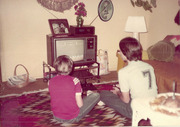tv Palo Duro Canyon CSPAN February 16, 2020 7:48pm-8:01pm EST
7:48 pm
yourself and pick up your own mind. campaign 2020, brought to you as a public service by gray television provider. -- by your television provider. visitstour of the continues as we take you outside the city to the second largest canyon in the united states. of drivingrience into the canyon today is like it has been for thousands of years. you come across this huge drop into the earth and even today, it is a shocking experience. the fact that i get to come and see this everyday, i just have to stop and take it in. and make sure that i am appreciating how lucky i am to get to be here every day. the canyon has been forming for about one million years or so.
7:49 pm
the bulk of the formation has happened in the last hundred thousand years. it runs from here to silverton. you can make a case that the canyon is at least 80 miles in length. the river is probably more like 120 miles. it is the second largest canyon in the united states after the grand. it is not a single canyon. there are many canyons that branch off to the sides. we are standing in an area where can see three canyons from where we are at right now. it is a much bigger system than people realize even with a brief visit to the state park. >> i grew up here in amarillo. as a young kid, i remember coming out in elementary school. and after that, as soon as i got my drivers license, i was driving out here every time i could, bringing friends. we would explore some of the caves. we explored some of the caves right down there. i can tell you it is much bigger than what you think it is from looking up here. when you get into the canyon with your hiking stick and
7:50 pm
boots, you better make sure you have a lot of water because it is much farther than you think. there are all kinds of treasures out there we have been searching out for. one of the draws is just being around extreme nature. this, you could say is extreme nature. there are so many places out here that you can go up to and see the beautiful cliffs and rock outcroppings. when i was growing up, the only footage you had from the air was helicopter shots the local television stations would do and things like that. of course, when the drones got popular several years ago, i had to be right there. i am a gadget guy. it's another one of my shortcomings, i guess. i have to have the latest gadgets. of course, i have my drone out here. it was amazing. it was amazing. it helped having all that experience and knowledge of where to go to look at these
7:51 pm
things, from spending my life looking from the ground up, i knew where to go, i knew all of the places i wanted to go and get the view from the air down. i already had all these shots set up in my mind and went and executed as many as i could. there are so many places out here. you can stay on the trail and be suitably amazed with everything that you see and there is plenty to look at and take photos of and experience, but there are so many other places that are just off the trail. >> palo duro canyon is a story of edges. we are on the edge of a lot of different ranges for a lot of plants and animals. we are on the edge literally of a canyon. it has also been a place that has been on the edge of these battles, these conflicts between different cultures, on the edge of these cultures. for the vast majority of the history of this area and canyon, the people that came here were a nomadic.
7:52 pm
they did not build permanent structures. they lived in temporary structures they could move as they traveled. they were mostly following large game. in the earliest days, that was large, now extinct bison, things like mammoths, giant ground sloths, the ice age mega fauna that no longer exists. even later than that, we get into the late prehistoric period when they were more like your typical image of what you think of when you think of native americans. the southern plains region. the native american tribes here included the southern cheyenne, the comanche, the apache. and towards the end of the southern plains way of life here in the 1860's and 1870's, this became almost a stronghold for people trying to escape from the soldiers, settlers, hunters, people taking their land. because this was in the center
7:53 pm
of comanche territory, it was very hard to get to. of course, the native americans had thousands of years of knowledge of this area and the people coming into the area did not, so they used this is a stronghold to escape. there was a series of battles in 1874 that became known as the red river war. the most decisive battle of the red river war was what we called the battle of palo duro, which happened here in september of 1874. basically, the comanches and cheyenne set up a winter campground like they had for years on the floor of the canyon. they were under the mistaken impression that they would be safe, that they would be left alone in the canyon that winter. they did not realize the government had sent five separate columns of troops into the area to look for them, to root them out, to try to force them back onto the reservation in oklahoma. the fourth calvary of the united states army discovered their encampment late in september.
7:54 pm
early morning of september 28 in 1874, they dismounted their horses, these are cavalrymen, they led them into the canyon floor, and charged into the village of mixed native americans. it is not a battle that had a high casualty count. it is more of a rout. imagine waking up and you are laying there with your wife, your husband, your grandmother, your children, all of these people are with you. and you wake up to armed soldiers attacking your town. what would you do? they did the only thing they could do, which was to flee. they ran, setting up pockets of resistance to hold off the soldiers long enough to escape. most of the native americans were very successful getting away. the problem was in their flight, they were not able to take much with them. they gave the fourth calvary the opportunity to come back and destroy their winter encampment, destroy all of their supplies. they also destroyed the bulk of
7:55 pm
their horse herd, which for the comanches was their way of life. that was how you travel, thought, hunted. that was a big load to their way of life to lose not only their winter encampment but their horse herd as well. over the months, they slowly trickled back into the reservation and that ended the southern plains way of life. a couple years, a new group came in and saw the opportunity of this empty place. empty of people, at least. those were ranchers. the first one here to set up a permanent ranch was charles goodnight. he arrived in 1876 and started a ranch. it grew through the 1880's. it was about 1.3 acres at its largest size. it was one of the largest in texas. not the biggest, but a big one. a lot of that encompassed parts of the canyon behind us. this was great grazing land for bison and it worked great for the cattle they brought in also.
7:56 pm
the ranching period in this spot lasted until 1933. from 1876 to 1933 this was a working cattle ranch. in 1933, the state of texas purchased about 15,000 acres that became the original state park. the people of the area had a strong desire to have a park here. prior to this being a park, if you did not know someone who owned some of the land, you had to trespass to see it. it was all privately owned. the landowner here had some events where they allowed people to come out and visit the canyon. sometimes tens of thousands of people would show up in the 1920's and 1930's to see it. just a huge drive for amarillo, but also surrounding cities wanted a park here because they knew how important it was to protect and how big of a boon it would be to have people come from all around to see it. the ranching continues all around us.
7:57 pm
but we are this little pocket of public land that people can visit. that is part of what makes this so special. we would not have a park here if not for the civilian conservation corps. they were a new deal relief effort, one of the many groups started by president roosevelt in the 1930's in response to the great depression. they arrived here shortly after the creation of the ccc. they arrived here at balladur. one of the oldest parks in texas and across the nation. they got here in the summer of 1933 and set up their camp. one of the first projects they worked on was the road into the canyon. obviously, you cannot build the rest of the facilities until you have access to it. it is a reminder i give myself all the time when i come through the canyon, when i'm driving down every day, that they built this road by hand basically for $30 a month, $1 a day.
7:58 pm
it changed their lives in that they were able to feed themselves, provide for their families, and they learned a lot that served them well later in life. it also provides for us today because we have so many amazing historic structures, the road into the canyon. without their work, we would not have everything we have today. >> you know, being up here in the texas panhandle, there is not a lot of written history. there is not a lot of history you can go back to and look at. this is one of those places you can go back and look at some of the history of the mortar stones. there is a rock that had indian art from probably 2000 years ago that you can still go to. it looks -- sure, it is not as vivid as it was back in the day, but it is still pretty vivid. i like that connection of being able to look at history that is more than just your
7:59 pm
grandfather's history. >> texas state parks, state parks across the nation, national parks, these are your public lands. we want people to visit them and join us in our mission of stewardship of these places. we are here as stewards, we are here as caretakers of the lands for other people. i always ask schoolkids and they come in, who owns balladur canyon? they almost always say, me, i do, or you do. it would be cool if i did, but i don't. this belongs to the people of texas where the people of the nation. the people of the world. we want them to come here and see this. we want them to understand how critical they are to the mission of stewardship of this place. >> >> our cities tour staff recently -- to amarillo, texas. you're watching american history
8:00 pm
tv, all weekend, every weekend, on c-span 3. >> next on the presidency, william allman, former white house curator, talks about the white house east room. hewoin the program as hugh to talks about renovations the museum in yorba linda, california. anyrue to form, with facelift, we need chiseled gins. --in theour copies of white house to collection and hang in the east room. these are brand-new reproductions that were done with the
56 Views
IN COLLECTIONS
CSPAN3 Television Archive
Television Archive  Television Archive News Search Service
Television Archive News Search Service 
Uploaded by TV Archive on

 Live Music Archive
Live Music Archive Librivox Free Audio
Librivox Free Audio Metropolitan Museum
Metropolitan Museum Cleveland Museum of Art
Cleveland Museum of Art Internet Arcade
Internet Arcade Console Living Room
Console Living Room Open Library
Open Library American Libraries
American Libraries TV News
TV News Understanding 9/11
Understanding 9/11










